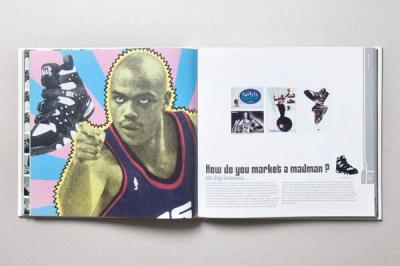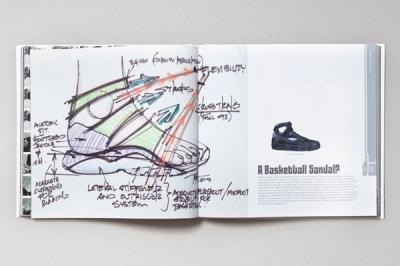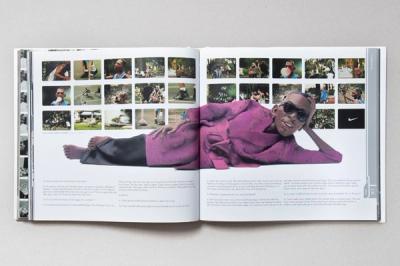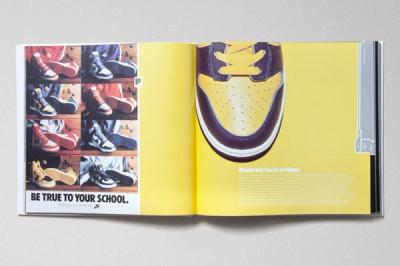Ten Years Old: Scoop Jackson Talks Sole Provider!
It’s hard to believe but it’s been over 10 years since Nike released Sole Provider: Thirty years of Nike Basketball. (Coincidentally, it was released the same year and same month as the first issue of Sneaker Freaker magazine, but that’s a whole other story!) For anyone who hasn’t seen this glorious book, Nike’s transcendent history in basketball is told through powerful images and street-smart words by award-winning ESPN columnist Scoop Jackson. From the elaborate marketing schemes to the player’s feet the shoes graced and the subculture that surrounded the whole deal, Sole Provider helped legitimise the claim that Nikes were more than ‘just a pair of shoes’. Recently I had the chance to sit down with Scoop and discuss how the book came together. Jackson was quick in deflecting praise, crediting Ray Butts (Nike’s then Global Brand Design Creative Director for Basketball), as the genius behind Sole Provider.
By Christopher Cason
How did you become the author of the book?
It was Ray Butts from Nike who called me and said ‘We’re thinking about doing this book, the 30 year history of Nike Basketball’. I was like ‘That’s dope!’ and I just ran with all this shit that I thought they needed to do in the book. People always call me for ideas, consulting and all that stuff, and it’s funny because Ray just remained silent while I talked. After I got through rambling, Ray was like ‘I was calling to see if you would be interested in writing the book’.
At the time, I was an adidas guy. I had never really fucked with Nike like that. That’s why it really caught me by surprise. It was just like ‘We want you to do it’. Later Ray was like ‘Remember the first time I called you and you started running off all these ideas? You were the right muthafucker to do it’.
Being an adidas guy, was it a challenge writing a book on Nike’s history?
It wasn’t a challenge because I was the only person that wasn’t a Nike guy. I was an adidas dude but I lived Nike’s whole story through all my boys. I watched my step-brother Mike blowout the first Blazers that were glued. He was like ‘I ain’t fucking with Nike no more!’. I was wearing adidas Superstars and they were stitched. When it came time to tell the Blazer story, that’s the first story because I watched it happen. When I talked to someone in design from Nike headquarters, they said blowouts were an issue.
It wasn’t an isolated incident. When they came out with the Ndestrukts and the Legends, my boy Kevin was like ‘These are the best playground shoes ever!’ and he was a Nike guy, so I had to listen to that. When it came time to tell the Legend story, I remembered that. Even though I wasn’t a Nike guy, the people around me were true to Nike, so I had stories already in my head because I had lived them through someone else.
The words seem to match the visuals perfectly. How did you guys work together?
If you look through the book, my approach was almost like a competition. It’s like old school Big Daddy Kane and Kool G Rap, where they would never battle each other, but anytime they were in the same place, on the same track, in the same studio, they were trying to outdo one another. My whole philosophy was to try to outdo what Ray was doing visually.
We did a lot of this book at a place in San Francisco. That was like our Batcave because that’s where we designed the book. Ray and I went to ‘Frisco maybe five or six times throughout the process and we spent four or five days just knocking it out. I would get to see what he was working on with layout and design. It was like ‘Oh shit!’ when he did the image of the Blazer on the mink. When he showed me that image, I knew it wasn’t going to be regular shoe shots; he was coming with some craziness. I was like ‘This fool has shoes on mink!’. My thing was ‘How am I going to out-write that image?’. We did it shoe-by-shoe and I’m looking at these shots and it’s not just clean shots, he’s taking things out of focus. Ray is a genius. I realised that I was fucking with a genius. You don’t ‘see’ what Ray sees. I don’t ‘see’ the concept of putting dirt on an Air Force 1 to represent Rasheed Wallace. I think it was the Flightposite that was submerged. Where do you conceptually think ‘I’m going to submerge a shoe underwater and get a photographer?’. The Hyperflight with the paint swatches? It’s not like he’s just came up with this as we went along, he knew. When you’re around that type of genius, it amazes you.
Every one of the images were full-scale photo shoots, lighting and everything. He knew the story he wanted to capture through the images and the images tell the whole story. It’s his project. He’s never taken as much credit as he should have. I’ve gotten a lot more credit than I think I should have. It’s really his concept.
I just tried to match what I saw him doing. He made me write. I’m not going to lie, he made me write.
What did they say in Remember the Titans? ‘Attitude Reflects Leadership.’ Same thing, I think behavior reflects leadership too. Ray was no joke.
I’m sure this changed your perception of Nike?
Yeah, without question, and I have to give Nike credit. The main and first thing Phil Knight ever told me is, ‘This is not a shoe company, it’s a marketing company’. That changed my whole perspective of everything. When you go in that office and you see all those marketing awards they have, it really validates that they’re a fucking marketing company that does great in athletics. They don’t cut any corners on anything they do to advance the culture of athletics. That’s why they’ll spend so much money to do certain things that either succeed or fail. Whether it’s from a technological standpoint, something that no other company would do, they make that investment because they want to advance this culture. But at the end of the day, in their minds, it’s still a marketing company because they still have to sell stuff.
They don’t approach it with the luxury that they may have, which is just putting out product with their name on it. They’re not like an artist who says ‘I’m on such a roll right now, I can put out some bullshit and everyone is still going to buy it’. They have 80 percent of the basketball market, as far as shoes are concerned, but they act like they have 10 percent. They’re still on that hunger tip. To hear it from Phil Knight, that shaped my entire directive on what I understood they were about.
What sort of access did you have?
They were like ‘If you’re going to do Sole Provider, we’re not going to give you some bullshit, we’re going to let you know about this whole fucking company, in, out and upside down’. I felt like I was an athlete, like I was Kobe. I’m pretty sure I got the exact same treatment as Kobe when they were trying to bring him over there, if not better. Mine lasted for a long time. Even after I signed on, they still did stuff for me that you just don’t expect. I became a wear-tester because they knew I still hooped a little bit. So I was always playing ball and going back to them with feedback.
One time, we were out in LA and Sole Provider was a year-and-a-half-old. I couldn’t check into my room and I couldn’t understand why. Everybody else’s room was ready except for mine. They were like ‘Mr. Jackson, we had to switch you out of your room, sorry for the inconvenience. If you don’t mind, we put you in a suite’. It had been a couple of hours so I was like ‘Cool, whatever’.
I go into my room and these fools had 19 pairs of shoes across the room like Easter eggs. I’m thinking ‘How the fuck am I going to get this back to Chicago?’. I don’t know any company that would do stuff like that and they did stuff like that for me. I was there for four years, so amazing, just amazing.
What did the book do for you?
I think it did validate me as a possible leading literary voice in sneaker culture. I don’t think I would’ve reached the level I did without the book. It kind of cemented the fact that this voice is legitimate. The one thing about being in the magazine business for as long as I have is you understand that magazines are still a disposable source of literature. Newspapers are the same way, to a degree. But magazines even more so, because they’re more specialised. It’s harder to gain a sense of true credibility as a writer when you’re doing literary work in magazines as opposed to doing books. Books validate you. It’s almost like acting in television as opposed to doing film. Once you reach film, it validates what you do because you can actually carry a movie. Film is the pinnacle. I think that’s what Sole Provider did for me.
There’s been so many great marketing campaigns in Nike’s history, but which is tops for you?
The ‘Barbershop’ ads, to me, were brilliant because they were so honest and had a feel of authenticity to them where they didn’t seem staged. That’s the one campaign that I wish I was part of. When they’re sitting in the barber chair and Chris Webber is telling the story of when he dunked on Charles Barkley and George Gervin is talking about his finger roll... they had the coolest muthafuckers in that barbershop.
I can think of a whole bunch, but from a commercial standpoint, and I hate to say it, the ‘Revolution’ campaign was massive. That was from a whole different era of editing and using music to sell a product in a different way. The pace of that whole campaign, using The Beatles’ music and running as a part of that, was strong.
But the one that affected me the most was the John McEnroe ad. The Brooklyn Bridge is in the background and he’s just standing on the side of it. It was him in his James Dean moment. Leather jacket, jeans, those sky blue, low-cut tennis Blazers and a tennis racquet in his hand, looking hard as hell. It was just McEnroe and it was New York. Still to this day, that is it for me. It reached that cool factor of George Gervin sitting on that ice.
Have you had the opportunity to sit back and reflect on Sole Provider since it was released?
When you brought it up, I was like ‘Damn, it has been 10 years’. I really haven’t had time to sit down, reflect and look back. I wouldn’t do that unless I had Ray with me. I need to go out to Portland and commemorate it for a couple of days, have a couple of drinks and remember. The only thing about me that’s on that book is the words I wrote and my name. I understand that this is really not my project. It’s Ray’s vision, his thing, and I just look at myself as a vessel. You know when they do the TV reunion thing, where they bring the cast back on shows. Ted Danson can’t do a Cheers reunion without saying ‘I gotta have Norm with me, Carla, Woody and Cliff’. I can’t sit back, even after 10 years, and reflect without having Ray around. That book was released back in November 2002, so it will creep back and someone will have to make a trip. Just to have a bottle of champagne and a toast to 10 years, then that will be it.






